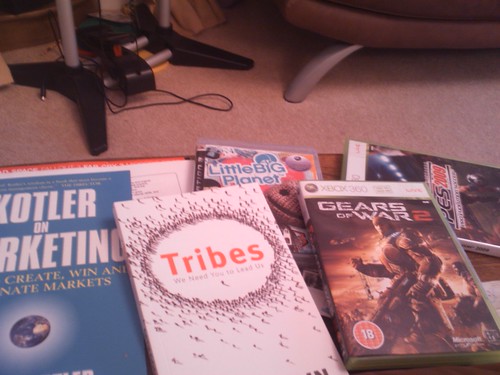AM Radio is a fantastic artist and designer and fellow eightbar in Second Life. I was sitting with twitter zooming past and Malburns twittered Hamlet’s article on New World Notes saying AM Radio had a new build, so I popped along and was once again amazed at the intricate detail that AM puts into things. Astra Thorne was there, so the beauty of the immersion of Second Life and having a common friend in AM we got talking. Astra mentioned some of the delightful details and mid west references on this project. The hood ornament in green is just brilliant.
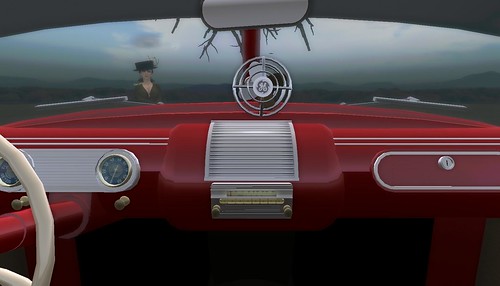
So once again, I popped into a place, based on a feed recommendation from a friend and made a new aquaintance, another person who feels the same way I do. The serendipty engine was in full flow. It cannot be ignored, the number of times these connection happen, in this case midnight for me whilst tidying up some late night work items.
Author Archives: epredator
Inspired by the social entrepreneurs – 3d Printing for the world
I have just spent 2 days fully immersed in the chain reaction event in London. At this very vibrant event I was expecting to spend most of my time explaining to people how we use the web and virtual worlds to communicate, to get things done, to power change in business. I certainly did get to do that, but I also got to meet and talk with a whole host of people from very varied backgrounds who had fantastic stories and goals.
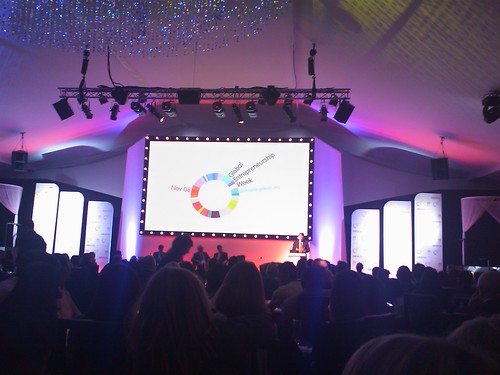
Many of the people at the event were social entrepreneurs. People who work for change in the commnuity and an better world, not merely profit. In fact seldom for profit.
There was of course a balance as there were some very important business leaders at the event and the prime minister at one point. They spoke of generating wealth, of running successful businesses but then setting up foundations and mentoring schemes. There were also a large set of the attendees(contributors) who were of a much younger demographic. Young people who were willing to hear about how they can make a difference, or more often those that already were just getting on with it.
One of the huge messages, and the biggest take aways from this was that you do not have to wait to get started doing anything. As Dr Victoria Hale (founder of One World Health the not for profit pharmacutical company) said, just when is it that you will have enough money, resources, people or power to do what you feel you need to do to change the world for the better? You just have to start.
There was a meta layer to the event in talking with production team called in to help with the social media reporting. All very experienced web 2.0 people. So we all had a lot in common and had some breakout sessions on where this is all going, and what the best way to produce events, gather whats happening and distribute it.
Finally the chain reaction is about the links people have made sparking ongoing work. The third sector (a very strange name but its a tribal label) is there to make a difference to the world. I wrote a commitment to be placed on the wall, one of many that were added that I want to get the technology of 3d printing, local manufacture to be distributed and practical around the world. Being able to manufacture designs from 3d data held elswhere in the world could allow local communites to manufacture the things they need from simpler raw materials. Imagine being able to fix a broken water pump, or create new water carrying vessels without the need to have products shipped to remote, deprived areas. Think one laptop per child, people finding the parts they need online or co-desiging them in a virtual world with remote engineering experts and add local 3d printing manufacturing abilities, making the virtual designs real to fix any problem. Now that can change the world, and I can help make that happen.
Chain Reaction – Changing the world tomorrow
It’s time to go and inspire the next generation of entrepreneurs at a 2 day event in London called Chain Reaction. “Chain Reaction is a unique and challenging project based on a very simple idea – that none of us on our own can change the world, not governments, not businesses, not charities. We succeed when we work together”. Sounds familiar doesnt it 🙂 Tribes? Smart Planet? Eightbar? well thats why I am heading along to share my experience and learn from others too.
Well a whole host of industry leaders will be offering their time and their insight to the audience of 1,000+ people, mostly under 30 years of age apparently.
Our UK Chief Exec Brendan Riley is in a session on the monday. Also Andy Dean ( a fellow eightbar from Hursley and I) will be in attendence for the full event, probably running the odd workshop here and there, mingling and helping people realize their full potential.
For me to be able to either talk about life online, the rise of metaverses or the story of eightbar and Godin’s tribes approach should keep me failry sparked and busy for the event. If I can persuade even just one person to just start doing, dont wait, dont overplan, start. Then it will be a success.
The main speakers are really awesomely impressive, including the great Richard Branson
So if you are going to be there, come and say hi.
Chainreaction in on twitter and spread over the web as you might expect and I am sure many of us will be live twittering, webcasting etc as its that kind of event.
I liked Godin’s tribes so much here are some more thoughts
This started life as an internal IBM post, to my tribe there, however, I liked it so much I wanted to share it more widely, just changed a few words.
As I have mentioned before I am so pleased that Seth Godin’s tribes book is as good as it is. Seth states these 5 things to do and 6 principles that as leaders (which we all can be should we choose to connect with people and care about something) we should do.
Every leader cares for and supports a movement, that movement can now be 10 people, 10,000 people, community, work colleagues, global or local.
The 5 things to do really should resonate for anyone who has chosen to associate with eightbar and/or the internal IBM Virtual Universe Community. If you have a passion and want people to gather around then this helps (as this worked for eightbar out of instinct it may help to see some structure to let you know how doable this is to make change).
This is particulary interesting given the doom and gloom at the moment. This is precisely when the leaders of the future will already be working the networks.
Things to do
1. Publish a manifesto (it does not have to be written just known)
2. Make it easy for follower to connect with you
3. Make it easy for followers to connect to one another
4. Realize that money is not the point of a movement, it exists to enable it. The moment you cash out you stunt your movement
5. Track your progress, publicly
Principles
1. transparency is the only option
2. movement needs to be bigger than you
3. movements that grow thrive
4. movements are made most clear when compared to the status quo i.e. when they are noticebly different not the same as another movement
5. exclude outsiders (a powerful force is who is not part of the movement)
6. tearing others down is never as helpful as building followers up
If you consider the first 5 things to do and think eightbar.
1. Publish a manifesto – we exist to explore virtual worlds and web2.0, to look out for one another and help as best we can.
2. Make it easy to connect with you, well, blogs, Second Life, phone, email, inside and outside the firewall. everyone is important.
3. Make it easy for followers to connect with each other. as above. Thats the beauty of the virtual world as the movement enabler.
4. Realize money is not the point. There may be some corporate arguing on this, but as with Linden their mission statement is to improve the human condition. There is profit in this, but the purpose is to make life better, for us to connect more to be able to share ideas and get things done. If those things are ‘business’ then great, if they are philanthropic then great too. (This fits nicely with smart planet I think)
5. Track your progress, publicly….. Er yes. http://www.eightbar.com and this blog and all the other blogs and twitters etc. The worst thing we do is keep things to ourselves.
On the principles I think they are fairly obvious. The exclusion (5) may seem a little strange,but if you think about it, eightbar was for IBMers as a group or movement to join. We have a few external advisors, alumni and guests occassionally. However the flag we rallied around was IBMers with a passion for change, and enabling that with virtual worlds.
So, anyone, absolutely anyone has the ability to share what they are doing and gather people interested in that around them. The web lets this happen. So next time you are thinking I wish x would happen or y would get going, dont wait. Web 2 is Web do. Start now. If you have an excuse as to why not, protecting your position, too many emails, the world does not work like that, thats the way it has always been etc. well you are missing out of making a real difference to a whole lot of people.
Its not easy to carry on leading, you may get laughed at, criticized but that usually indicates you are doing the right thing. I also dont think the people hammering on you will ever stop either, if they do you need to take it further.
So what are you waiting for. Get on with it.
From Little Big Planet to a Smart Planet
As you know we don’t usually do press releases or “official” stuff here on eightbar, but the very recent words from Sam Palmisano around the drive for a Smart Planet do fit in rather well with what we have been doing over the past years.
Firstly Smart Planet is not directly named after our very own Rob Smart, but just as Second Life surnames act to aid serendipity we should not ignore that link.
Secondly, this is not really related to Little Big Planet as such, but there are parallels that can be drawn.
However the main drive behind the Smart Planet is around these three themes.
First, our world is becoming instrumented
I often talk about things being instrumented, but this fits in with the approach we took to Wimbledon in SL(first blogged in 2006), an instrumented world re-envisioned and experienced. It fits with Andy SC and DCJ’s work with sensors, actuators, current cost meters etc. It was the core of my business process management pitch at VW London. If we have the data, openspimes, facts, figures, messages then we can do a whole lot with it.
Second, our world is becoming interconnected
Well…. if you are reading this blog you know this is the case. This is not just about the data but about the people. Web2.0 and virtual worlds have connected us all in incredible ways, formed new tribes of interest, brought eightbar into existence. Being able to create and share across company and cultural boundaries, breaking geography, all fit into this from what I can see. This is where Little Big Planet fits too, even Sony dipping their toe into the great creative power of user created content.
Third, all things are becoming intelligent
This is the extra leap, but we can apply compute power to vast amounts of data as a service. We can also apply human power, the wisdom of crowds. Things are not isolated units of processing. We can gather insight and points to innovate on with more simulations and visualizations at a global level.
So bring on augmented reality, transparent sharing across interested groups, remote rich interaction between people and information at distance and new ways to determine what is happening in the real world.
So to finally quote Sam Palmisano “But I think one thing is clear: The world will continue to become smaller, flatter… and smarter. We are moving into the age of the globally integrated and intelligent economy, society and planet. The question is, what will we do with that?”
Tell me that does not fit in with all the drivers of virtual worlds that we and our fellow tribe members inside and outside of eightbar have been pushing?
Two bits of wood a motor and some sponge = LBP
My Little Big Planet for the Ps3 has arrived. Aside from some crazy and cool presentation styles and levels to play it does indeed have the most fantastic building kit. Many of us the last few years have got used to just making things in places like Second Life. Little Big Planet takes a seemingly more Blue Peter style with sponge, cardboard and a lot of sticky back plastic. Now I am no expert in building things yet but a minute or so yielded this quirky creation
What is interesting is that the style is photo realistic, but the setting is very homemade, so it allows photo realistic creations to make sense even when they are rough around the edges. The slapstick cartoon intentions and even the sackboy characters go nowhere near the uncanny valley, it is all utterly believable.
Eightbar a tribe Seth Godin would recognize
I have been completely blown away by listening to the audiobook version of Seth Godin’s new Tribes book. (Thanks to @ids for shining the light on this one for me)
Why? Well Seth articulates not what we should have done as our Eightbar tribe, but what we actually did. Every line had me nodding in agreement. He has saved me the bother to write the story of eightbar and how our particular tribe formed in and around virtual worlds as he has documented what has happened and can happen when anyone, anywhere steps up to lead people with something they believe in.
It may occasionally come across as a bit of a self help book, slightly American in its apparent dream, but as one of the many heretics he refers to who has used many of the channels, techniques and ideas to get things done and to help form a tribe it is completely true.

Seth talks about overcoming the fear that very often holds back people when they consider any form of change. Whilst written pre-credit crisis he referes to a previous crash, when half the people in particular real estate conference we full of doom and gloom and the other half, the mavericks, entrepreneurs and heretics saw the opporunity to rise form the ashes and make something happen.
He also points out (as I do) that there is nothing stopping anyone sharing their idea, creating their tribe, starting there movement right now, this instant. The gathering of people around a cause can happen at the push of a button on a blog post, NOT after you have been through some validation process by a mythical board of good ideas giving you the thumbs up.
I had to enter quite a self reflective mood when the book discusses the role of a leader, trying to keep the ego and self interest in check and doing things for the right reason. He suggests people lead not have statues made of them, but to do things that are worthy of a statue. A subtle difference. People who set out to rule, for self gain are sniffed out quickly by human intuition. Being able to use notoriety and public awareness for the good of the whole tribe is important. Not seeking fame but knowing how to use it. (That all sounds quite pompous but it is something that many of us feel I think).
The book also talks about the death of the factory, of old corporate structures based purely on time served and geography. Anyone who has heard me speak knows thats a pet subject for me. Not to destroy the corporate structure but to improve it, though that requires some bypassing.
It is the techniques many of us instinctively use that Seth refers to in the book, using the analogy of faith and religion. Not for any discussion of god per se. Faith is the belief in something, anything, an idea, a direction, a product, a group of people. Religion is often the rules and rituals that re-enforce that faith. He refers then to corporate religion, this is the way it has always been done, here is a process to follow and how that can then get in the way. Herectics have faith, they may appear to follow the rules, but in reality they are working for something to replace those rules with a better approach, and not leave things netrenched in “well its always worked that way”.
In some ways he is letting the cat out of the bag, but to keep the animal analogy he refers to many people in life who turn up for a paycheck and fear any change. He calls those people Sheepwalkers. Its a brilliant term and one that is now in my lexicon. It is not wrong to be a sheepwalker, but that is not fulfulling any human potential. He constantly throws in the question “how was your day?”. Aiming to help people understand that driving and leading change, working for a cause you believe in for a tribe of people that care about one another is way more rewarding than anything else.
Seth Godin is a marketeer, he is trying to help those in marketing understand that massive ads, swamping people with “messages” is not longer going to work. People choosing to follow something or someone, gathering together across the web, twitter, virtual worlds etc means is far more powerful and profitable than the “old way” in the long run. He makes an important point that if you are expecting the next thing to be better than the current thing on a 1:1 comparison then you will be missing the point. The next thing will evolve to be far better, the comparisons will not be valid and if you wait for the perfection of the next thing you will be too late.
This reminded me of the example of the visits to Second Life Wimbledon in 2007. When measured on web scale the visits were tiny, 200 people a day. as opposed to the millions to the website. Yet all those people were engaged with and talked to, bonds were formed. It exceeded the 50 people a day who visited as customers at the real venue, each of those is engaged with and talked to. Comparing, or demanding the right measurements and facts in place before doing anything does not work. I guess thats where faith comes in, an utter deep belief this is the right way forward.
So eightbar is a 6,000 person tribe made up of IBMers who are able to communicate and connect with one another. It has a feel, it has a reason to exist to explore to push the boundaries. It has also formed several different spin off tribes. The virtual universe community, with its charter, its guild leaders inside IBM, and it has caused the formation of the Emerging Business Unit for virtual worlds and digital convergence in a more traditional corporate structure. It also, as a tribe has people with an affinity to it, the people who are kindred spirits and fellow heretics pushing these ideas forward.
I am immensely proud of our tribe, what we have done and everyone in and around it. It is woven deeply into my life and history, and thats why seeing the very thing we are explained with other examples has given my faith a massive re-injection and validation.
We all rock!
Games and Business – Changing the Game
My amazon delivery arrived today of Changing the Game by David Edery and Ethan Mollick.
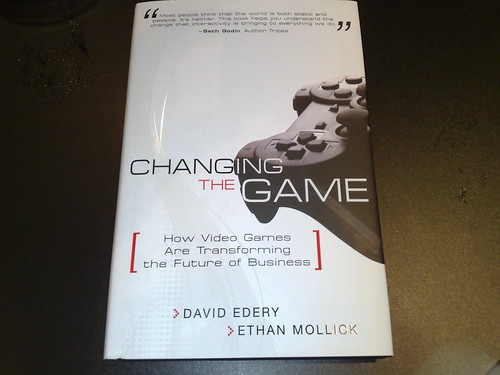
For many of us in this growing blended industry of metaverses, virtual worlds, serious games and such like this book may well be a busmans holiday. However, it is packed with evidence, facts and figures and useful imagery to help convince those who seem to think any game play elements at all in business really dont fit.
Well they do IMHO. Take a look at what David and Ethan have to say, as a great deal of business and academic experience is captured in this book.
One key element they point out is that the only way to understand anything at all about games is to play them or observe them very closely. The surface descriptions of many of the tasks and the game terminology often masks the true deep use and depth of advantages.
It is once again fitting nicely into the serendipity of life as I was having amny of these same conversations with the various visitors to my BAFTA studio session yesterday. You dont just have to make games and related environments you can use them.
Virtual Worlds London – metarati and moving coffee – Day 1 Part 1
Monday and Tuesday this week were the virtual worlds london conference So the Queen Elizabeth II conference centre across the road from parliament in Westminster was a hot bed of metarati activity.
The main conference hall is a very impressive UN like stage and sets of tables. It was hard to gauge numbers in attendence but it seemed quite busy.
The opening keynote was Mark Kingdon the new Linden Lab CEO. I had heard Mark talk at the birthday celebrations but it was also good to see him and hear how he saw Second Life now.
The pitch had to try and balance the potential of people in the audience not knowing about virtual worlds and the more experienced industry people too.
He showed lots of numbers and spoke about the growing peak concurrency and improved stability.
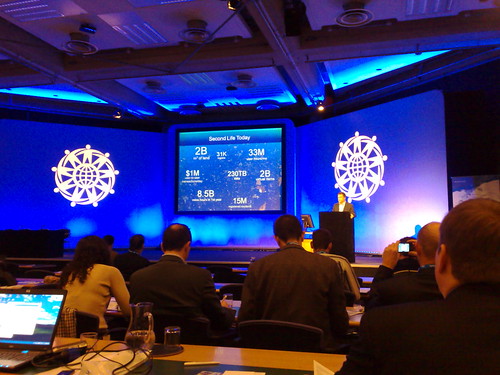
He also indicated that whilst not a product announcement as such that 1st Quarter 2009 woudl see the beta of the behind the firewall enterprise Second Life. Of some interest to us in eightbar as IBM has been part of that drive and research as we have some servers behind the firewall so I guess we are alpha participants 🙂
The drive to a more corporate approach and the enterprise market whilst not losing the creative and eclectic set of public communities is an interesting balance for Linden Lab to take. Some people did comment that the many Linden’s in attendance and Linden stand was very suited and booted as we say.
There was also a joint strategic partnership that saw Justin Bovington from Rivers Run Red take to the stage showing the immersive workspaces video and explaining it for the audience.
Also in the keynote M Linden finished on a very good point that these virtual environments whilst very much about people and integrating with others can also be a place fo great solitude and personal reflection.
Ren Reynolds(Now a Fellow of the Royal Society for the Arts (FRSA) many congrats!) twittered “@epredator virtual worlds as pause to think, now they are doing my pitch ! oh and behind F/W see Biz Case i did 3 years ago! ” and I was reminded of a post I made back in 2006 about remembering to relax in Second Life too.
After this the next session was “Trends and Numbers – Where is it all going?”. Each presenter gave a pitch. Harvey Cohen from Strategy Analytics showed some research results mainly around what ubiquity meant and needed to be and how we were not there yet. Nic Mitham of K Zero showed some of his excellent charts on worlds, demographics and those new middleware platforms coming of age very soon. Then Steve Prentice from Gartner aimed to remind people of my favourite opener “this is about people”
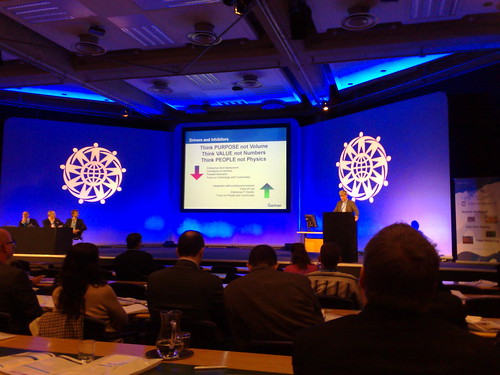
Think purpose not volume, think value not numbers, think people not physics.
(Being very much on the receiving end of trying to justify what this is all about these are things I am very much tuned into. It is almost a description of what to do with your evangelists too).
We then all went for coffee and expo time. The expo was a little odd in layout, it was over two floors that we sort of corridoors, sort of mezzanine levels. The natural flow was not to go from one floor to the other as the electives were either in the large ground floor hall or the 4th floor in more of a long office. The moving coffee reference in the title was because each coffee break the coffee would rez on a different floor to induce a green dot effect and have people mingle around the stands with some sort of engineered distribution. Of course virtual worlds, whilst getting more serious and business like, tend to attract a more up and at ’em audience and I am not sure the coffee moving was very popular.
The expo had a few stands but was no where near as large as the US expos. IBM did not have a stand either though there were a few of us there speaking. The biggest and most populated and staffed stand though was the Second Life one.
The first elective I attended was Defining Your Strategy: what does ROI mean to you. Chaired by the ever present Corey Bridges of Multiverse. Phillipe Moitroux of TAATU, Divinia Knowles of Mind Candy and Peter Haik of Metaversatility were the panelists. Phillipe showed a presentation ot TAATU and explained some of how they used their 2.5d flash world to integrate with marketing and media campaigns.
Corey was challenging the panel to give numbers for ROI and taking the stance that there has to be ROI for investment to be proved. Mind Candy’s Moshi Monsters though is in early take up phase, to get buy in before any monetization so there were no figures, as you would expect. Peter indicated that some of this need to be looked at as presence and that the ROI is complicated to show in that case. This led to some discussion from the audience about the balance of how to measure PR vs how to measure marketing. It made for a prickly but good start and Peter was up for arguing with Corey over the need and intent for some of the virtual world projects. Of course multiverse is more about building virtual worlds and metaversatility is about doing things in them so that is comparing two different things really anyway.
I then left the main hall and tooke the lift to the 4th floor (again bypassing the expo) for the “future of virtual collaboration in the enterprise”. Bernard Horan of Sun, Rupert Key of Malden Labs, Chris Collins Linden Lab and Paul McDonagh-Smith Nortel talked about all the various projects and directions for enteprise virtual worlds. Chris obviously added and re-iterated the keynote mention of the 1Q beta, Paul talked about the various Nortel projects and products emerging, Bernard covered many of the aspects of using multiple platforms and Project Darkstar, and Rupert described how some of the more rigourous software engineering was coming into play. He used the SOA (services orientated architecture) word first and ESB (enterprise services bus) 🙂 Small cheer from me there.
For me this session was more about the “coming of age” as Tish said, of the enterprise virtual world. All these great companies, all active, bought in, selling solutions, building solutions. Its not going to go away and may be the biggest driver for VW take up. Not everyone will play a game who works in a office, their kids might be in the kids worlds, they may explore a social media platform. However, many more people use email at work, use computers as tools of the trade. Injecting virtual worlds into that points towards the ubiquity we are straving for. That also starts to make this a “platform”, onto which new innovations will occur. All very exciting for this metaverse evangelist.
The post lunch session began for me with the “Rise of Mirror Worlds and Mirror World Applications”. Now dont get me wrong I like mirror worlds, but I was more taken with the sort of augmented mashup approach that David Burden of Daden took in showing the mirror world potential than initially the approach of Alex Wrottesly of Near and Mirko Caspar of Metaversum (Twinity). Alex was basiclaly coming out of “pseudo stealth” and sharing the Near concept of a 100% accurate model of a city with managed shop fronts and interiors for all the parties involved in the real place. Twinity was showing virtual Berlin and the sort of activities and popularity of having a real place to socialize in.
David showed google maps mashups with aeroplane arrival data and layering of reality with augmentations from various places.
David Wortley from Serious games was moderating, but I was late getting into the room so only caught the end of of his intro.
Near was challenged on the need to be 100% accurate all the time. How does that get to happen. Self management by store owners in real life seemed to be part of it. An interesting focus. Also Kevin Aires asked if someone did not have a real presence surely they could not participate. (I was thinking that too as IBM does not have any shops, not does Amazon). The answer was that if they were not in real space they would not be in the model, though it raised the notion of people buying up real estate in order to occupy the virtual model which might have a wider reach that the real place. Complicated conundrums.
Personally I think that accurate models of real places do make sense, its what the Ordnance Survey spend a lot of time creating. A sort of managed wiki approach for store front owners may seem an overhead that they may choose to not enagage with. However, an accurate model, instrumentated with whats going on the real world, a paraverse as our Collegue Peter Finn refers to them makes alot of sense. Maybe populated with openspime data. That is accurate and valuable. Though virtual tourism and visiting places clearly has its attractions. I love driving at speed around the Project Gotham version of London on my Xbox 360.
The penultimate session was virtual worlds as interactive television. I missed some of this due to another gathering elsewhere. However the gist seemed to be that television needed to adopt a way to engage with the audience and that various projects try to do this in various ways. The problem often being that simply repackaging an experience based on a TV show of film doesnt work very well, but that creating an engaging all platform experience is veyr hard to do. I was reminded of the sort of conversations that Tim Kring of Heroes fame was having in LA. He suggested that hollywood was not very good at seeing the potential, but merely treated everything as being able to shrink wrap it in the next format. Film, to DVD. etc. He, as a story teller and creator wanted to layer across all the engagement points.
The final keynote was a call to arms for the Virtual Worlds Roadmap. This needs a post in its own write as we all need to get on board with this across the industry and help. Victoria Coleman (Samsung), Sibley Verbeck (electric sheep company), Jeffrey Pope 3Di, John Hengeveld (intel) and (at last I got to meet him for real and he is now busy helping NASA work out how to deflect extinction level event asteriods from Earth!) Bruce Damer were all on stage giving their view. The main aim is to gather together and cut through use cases to understand and help people come to terms with which applications need to be built for which case.
(In my own humble way I have been trying this with my reverse ICE model)
The gathering up to now have been physical ones as people got together to solve break the problems up, but we very much need to all get involved and spread this voluntary effort across the metaverse community. I certainly would like to see the 6000 IBMers all contributing from the virtual universe community in the near future.
It’s here the virtual worlds roadmap. lets do this!
Long post… Day 2 next post
Virtual Forbidden City – Live. History in the making
The virtual forbidden city project, beyond space and time has now gone live.
This has been a fascinating journey to follow, that is as much part of the history of my involvement in virtual worlds as anything.
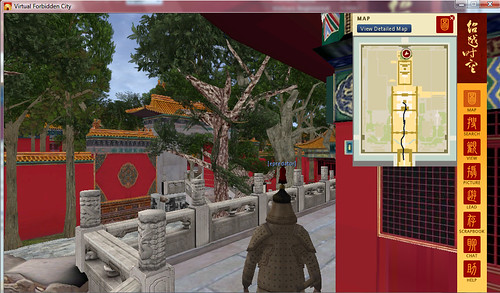
Way back in 2006 John Tolva and I bumped into one another again, having both worked together on Wimbledon and also having helped with another of the projects that came to Hursley for some extra development skills from Rob and Daz and many others.
John had hit the nebulus Second Life on the same day as I had, for no reason that we could fathom. We then noticed one anothers blog posts.
So the famous virtual world serendipty that I have learned to trust kicked in veyr early.
John was exploring options for the project that rolled on from his previous one of Eternal Egypt. John specializes in running large innovative projects that use the web for more philanthropic reasons as part of what is called corporate community relations.
So there we were in SL, I had my personal shiny new island Hursley and he and his team were looking at how they might represent the forbidden city in the growing world of the virtual, non game metaverse.
So I loaned the team the island, and a massively detailed chinese build started to form in the sky over the next few weeks whilst they procured their own official island.
That island then became the venue, after the 2006 innovation jam, for our CEO Sam Palmisano to announce virtual worlds as one of the top five findings from this virtual chinese palace, and getting this all on the cover of business week.
So Second Life proved a testing ground, but the development then moved platforms to a more controlled environment. The team chose Torque. (Yes the very same platform we used for the initial CIO metaverse work so you can see how this flow is going!). As this was a service that was focused on one subject in many ways, like a game, it does not need the full dynamic nature of SL. Also the scaling of this needs to work in a different way, running on and with underlying IBM infrastructure this becomes part reference account for being able to build and run things. Being torque the client download is large(ish) as it contains most of the reosurces you need as there is no need to stream the forbidden city all the time as its not constantly changing in structure, though new content can be delivered.
John’s post on the launch is the best reference I think (hence only a single picture here from me). You will also find it on IBM.com
One other feature that I always have to mention is the ability to not just follow NPC tours, but to be a tour leader yourself. This means teachers and educators can guide a tour around adding their own structure to the experience for a willing group of participants.
Enjoy Beyond Space and Time

